Art Gallery of Ontario
 Dundas Street façade of the AGO, designed by Frank Gehry | |
 Location of the gallery in Toronto | |
| Established | 1900 (1900) |
|---|---|
| Location | 317 Dundas Street West Toronto, Ontario M5T 1G4 |
| Coordinates | 43°39′14″N 79°23′34″W / 43.65389°N 79.39278°W / 43.65389; -79.39278 |
| Type | Art museum |
| Visitors | 873,000 (2016) 3rd most visited nationally 79th most visited globally |
| Director | Stephan Jost[1] |
| President | Robert J. Harding[2] |
| Curator | Julian Cox |
| Public transit access |
|
| Website | www.ago.ca |
The Art Gallery of Ontario (AGO) (French: Musée des beaux-arts de l'Ontario) is an art museum in Toronto, Ontario, Canada. Its collection includes close to 95,000 works spanning the first century to the present day.[3] The gallery has 45,000 square metres (480,000 sq ft) of physical space, making it one of the largest galleries in North America. Significant collections include the largest collection of Canadian art, an expansive body of works from the Renaissance and the Baroque eras, European art, African and Oceanic art, and a modern and contemporary collection. The photography collection is a large part of the collection, as well as an extensive drawing and prints collection. The museum contains many significant sculptures, such as in the Henry Moore sculpture centre, and represents other forms of art like historic objects, miniatures, frames, books and medieval illuminations, film and video art, graphic art, installations, architecture, and ship models. During the AGO's history, it has hosted and organized some of the world's most renowned and significant exhibitions, and continues to do so, to this day.
The Art Gallery was founded in 1900 as the Art Museum of Toronto. The Gallery was renamed to the Art Gallery of Toronto in 1919, and finally the Art Gallery of Ontario in 1966. Since 1974, the gallery has seen four major expansions and renovations, typically considered a high number and unseen by most galleries of the world, and continues to add spaces. The renovated and renamed J.S. McLean Centre for Indigenous & Canadian Art opened in July 2018. Prior recent renovations by Hariri Pontarini Architects include the Weston Family Learning Centre, which opened in October 2011 and the South Entrance and lounge outside the library, which opened in July 2017.[4] The David Milne Research Centre, which opened in April 2012, was designed by KPMB Architects.[5] Earlier major renovations were designed by noted architects John C. Parkin (1974 & 1977), Barton Myers and KPMB Architects (1993), and recently, Frank Gehry (2008).[6][7]
In addition to display galleries, the structure houses an extensive library, student spaces, gallery workshop space, artist-in-residence, a restaurant, café, espresso bar, research centre, theatre and lecture hall, Gehry-designed gift shop, and an event space called Baillie Court, which occupies the entirety of the third floor of the contemporary tower. The gallery is located in the Downtown Grange Park district, on Dundas Street West between McCaul and Beverley Streets, near Chinatown.
The Art Gallery of Ontario is the second most visited museum in Toronto after the Royal Ontario Museum in 2014.
Contents
1 History
1.1 2004–2008 renovations
2 Selected major exhibitions since 1994
3 Permanent collection
4 Selected works
4.1 The Baroque
4.2 18th century Rococo
4.3 19th century
4.4 20th century
5 Library and archives
5.1 Edward P. Taylor Library & Archives
5.2 General library collections
5.3 Rare Books and Artists' Books
5.4 Archives and Special Collections
6 Online presence
7 Artist-in-Residence program
7.1 Artists-in-Residence
8 See also
9 References
10 External links
History

A south view of the first gallery building in 1922
The museum was founded in 1900 by a group of private citizens, members of the Ontario Society of Artists,[8] who incorporated the institution as the Art Museum of Toronto. The Legislative Assembly of Ontario subsequently enacted An Act respecting the Art Museum of Toronto in 1903. The museum was renamed the Art Gallery of Toronto in 1919, and subsequently the Art Gallery of Ontario in 1966.
The current location of the AGO dates to 1909,[9] when Harriet Boulton Smith[10] bequeathed her historic 1817 Georgian manor, the Grange, to the gallery upon her death. In 1911, the museum leased lands to the south of the manor to the City of Toronto in perpetuity so as to create Grange Park.[11] In 1920, the museum also allowed the Ontario College of Art to construct a building on the grounds.
The museum's first formal exhibitions opened in the Grange in 1913. In 1916, the museum drafted plans to construct a small portion of a new gallery building. Designed by Darling and Pearson in the Beaux-Arts style, excavation of the new facility began in 1916, and the first galleries opened in 1918. Expansion throughout the 20th century added various galleries, culminating in 1993, which left the AGO with , the 100,00-square feet of new space and 190,000-square feet of renovations—usable space was increased by 30 per cent, including 30 new and 20 renovated galleries.[12]
The AGO was and continues to be a major supporter of local arts, which have included shows for the Group of Seven, Betty Goodwin, David Milne, and Shary Boyle.
The AGO's First Founders include:[13]George A. Cox, Lady Eaton, Sir Joseph W. Flavelle, J.W.L. Forster, E.F.B. Johnston, Sir William Mackenzie, Hart A. Massey, Prof. James Mavor, F. Nicholls, Sir Edmund Osler, Sir Henry M. Pellatt, George Agnew Reid, Sir Byron Edmund Walker, Mrs. H.D. Warren, E.R. Wood, and Frank P. Wood.
2004–2008 renovations
@media all and (max-width:720px).mw-parser-output .tmulti>.thumbinnerwidth:100%!important;max-width:none!important.mw-parser-output .tmulti .tsinglefloat:none!important;max-width:none!important;width:100%!important;text-align:center
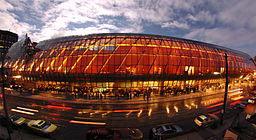

Under the direction of its CEO Matthew Teitelbaum, the AGO embarked on a $254 million (later increased to $276 million) redevelopment plan by architect Frank Gehry in 2004, called Transformation AGO. The new addition would require demolition of the 1992 Post-Modernist wing by Barton Myers and Kuwabara Payne McKenna Blumberg Architects (KPMB). Although Gehry was born in Toronto, and as a child had lived in the same neighbourhood as the AGO, the expansion of the gallery represented his first work in Canada. Gehry was commissioned to expand and revitalize the AGO, not to design a new building; as such, one of the challenges he faced was to unite the disparate areas of the building that had become a bit of a "hodgepodge" after six previous expansions dating back to the 1920s.[14]
Kenneth Thomson was a major benefactor of Transformation AGO, donating much of his art collection to the gallery (providing large contributions to the European and Canadian collections), in addition to providing $50 million towards the renovation, as well as a $20 million endowment.[15] Thomson died in 2006, two years before the project was complete.
The project initially drew some criticism. As an expansion, rather than a new creation, concerns were raised that the new AGO would not look like a Gehry signature building,[16] and that the opportunity to build an entirely new gallery, perhaps on Toronto's waterfront, was being squandered. During the course of the redevelopment planning, board member and patron Joey Tanenbaum temporarily resigned his position over concerns about donor recognition, design issues surrounding the new building, as well as the cost of the project. The public rift was subsequently healed.[17]


The AGO reopened in November 2008, with the transformation project having increased the art viewing space by 47 percent. Notable elements of the expanded building include a new entrance aligned with the gallery's historic Walker Court and the Grange, and a new four-storey south wing, clad in glass and blue titanium, overlooking both the Grange and Grange Park. The outwardly most characteristic element of the design however is a new glass and wood façade—the Galleria Italia—spanning 180 metres (590 ft) along Dundas Street; it was named in recognition of a $13 million contribution by 26 Italian-Canadian families of Toronto, a funding consortium led by Tony Gagliano, a past President of the AGO's Board of Trustees.
The completed expansion received wide acclaim, notably for the restraint of its design. An editorial in The Globe and Mail called it a "restrained masterpiece", noting: "The proof of Mr. Gehry's genius lies in his deft adaptation to unusual circumstances. By his standards, it was to be done on the cheap, for a mere $276-million. The museum's administrators and neighbours were adamant that the architect, who is used to being handed whole city blocks for over-the-top titanium confections, produce a lower-key design, sensitive to its context and the gallery's long history."[18] The Toronto Star called it "the easiest, most effortless and relaxed architectural masterpiece this city has seen",[19] with The Washington Post commenting: "Gehry's real accomplishment in Toronto is the reprogramming of a complicated amalgam of old spaces. That's not sexy, like titanium curves, but it's essential to the project."[16] The architecture critic of The New York Times wrote: "Rather than a tumultuous creation, this may be one of Mr. Gehry's most gentle and self-possessed designs. It is not a perfect building, yet its billowing glass facade, which evokes a crystal ship drifting through the city, is a masterly example of how to breathe life into a staid old structure. And its interiors underscore one of the most underrated dimensions of Mr. Gehry's immense talent: a supple feel for context and an ability to balance exuberance with delicious moments of restraint. Instead of tearing apart the old museum, Mr. Gehry carefully threaded new ramps, walkways and stairs through the original."[20]
Selected major exhibitions since 1994

Advertisement for King Tut: The Golden King and the Great Pharaohs, outside the Art Gallery of Ontario. The Gallery hosted the exhibition in 2009.
Mickalene Thomas: Femmes Noires (2019)- Tunirrusiangit: Kenojuak Ashevak and Tim Pitsiulak (2018)
Yayoi Kusama: Infinity Mirrors (2018)
Guillermo del Toro: At Home with Monsters (2017)- Free Black North (2017)
Rita Letendre: Fire & Light (2017)- Every. Now. Then. Reframing Nationhood (2017)
- Toronto: Tributes + Tributaries, 1971–1989 (2016)
- Mystical Landscapes: Masterpieces from Monet, Van Gogh and More (2016)
- Small Wonders: Gothic Boxwood Miniatures (2016)
Theaster Gates: How to Build a House Museum (2016)- The Idea of North: The Paintings of Lawren Harris (2016)
- Outsiders: American Photography and Film, 1950s-1980s (2016)
J. M. W. Turner: Painting Set Free (2015)
Jean-Michel Basquiat: Now's The Time (2015)
Francis Bacon and Henry Moore: Terror and Beauty (2014)- Frida & Diego: Passion, Politics and Painting (2012)
Berenice Abbott: Photographs (2012)
Picasso: Masterpieces from the Musée Picasso Paris (2012)
Iain Baxter&: Works 1958–2011 (2012)
Jack Chambers: Light, Spirit, Time, Place and Life (2012)
Chagall and the Russian Avant-Garde: Masterpieces from the Collection of the Centre Georges Pompidou, Paris (2011)- Haute Culture: General Idea (2011)
- Abstract Expressionist New York (2011)
- Black Ice: David Blackwood Prints of Newfoundland (2011)
- The Shape of Anxiety: Henry Moore in the 1930s (2010)
- At Work: Hesse, Goodwin, Martin (2010)
- Drama and Desire: Artists and the Theatre (2010)
Maharaja: The Splendour of India's Royal Courts (2010)
Julian Schnabel: Art and Film (2010)
Rembrandt/Freud: Etchings from Life (2010)
King Tut: The Golden King and the Great Pharaohs (2009)- Drawing Attention: Selected Works on Paper from the Renaissance to Modernism (2009)
Emily Carr: New Perspectives on a Canadian Icon (2007)
Catherine the Great: Arts for the Empire – Masterpieces from the Hermitage Museum, Russia (2005)
Turner, Whistler, Monet: Impressionist Visions (2004)- Voyage into Myth: French Painting from Gauguin to Matisse, from the Hermitage Museum (2002)
- Treasures from the Hermitage Museum, Russia: Rubens and His Age (2001)
- The Courtauld Collection (1998)
- The OH!Canada Project (1996)
- From Cézanne to Matisse: Great French Paintings from The Barnes Foundation (1994)
Permanent collection

Several sculptures from the gallery's collection is displayed at the Joey & Toby Tanenbaum Sculpture Atrium.
The AGO's permanent collection holds nearly 95,000[21] pieces, representing many artistic movements and eras of art history.
It includes the world's largest collection of Canadian art, which depicts the development of Canada's heritage from pre-Confederation to the present. Indeed, works by Canadian artists make up more than half of the AGO's collection, with works from Tom Thomson, Group of Seven, Emily Carr, and Cornelius Krieghoff, among others. This collection also includes Inuit and Indigenous art from the past and present, with artists such as Kenojuak Ashevak, Norval Morrisseau, and Jackson Beardy.
The museum has an impressive collection of European art, including a highly important collection of miniatures, sculptures, Medieval and Renaissance decorative arts, and major works by Tintoretto, Gian Lorenzo Bernini, Peter Paul Rubens, Rembrandt van Rijn, Thomas Gainsborough, Anthony van Dyck, José de Ribera, Francisco Goya, Emile Antoine Bourdelle, and Frans Hals, and works by other renowned artists such as Pablo Picasso, Auguste Rodin, Camille Pissarro, Claude Monet, Henri de Toulouse-Lautrec, Pierre Bonnard, Raoul Dufy, Paul Cézanne, James Tissot, Alfred Sisley, and Edgar Degas.
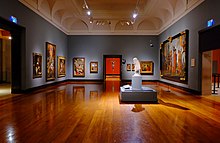
One of the rooms for the Tannenbaum Centre for European Art. The Centre has on display several pieces from the Gallery's European collection.
A key feature to the gallery is a modern and contemporary art collection illustrating the evolution of modern artistic movements in Canada, the United States, and Europe, including works by Franz Kline, Mark Rothko, Arshile Gorky, David Smith, Hans Hofmann, Joan Miró, Marc Chagall, Henri Matisse, Sonia Delaunay, Amedeo Modigliani, Yves Tanguy, Giorgio de Chirico, Salvador Dalí, William Kurelek, Michael Snow, General Idea, Jean-Paul Riopelle, Paul-Émile Borduas, Barbara Hepworth, Georgia O'Keeffe, and Jack Chambers, Other contemporary artists include Shary Boyle, Claes Oldenburg, Frank Stella, Jenny Holzer, Gerhard Richter, Micah Lexier, Brian Jungen, Sol LeWitt, Iain Baxter&, and Richard Serra. The collection also extends to installations, photography, graphic art (such as concert, film, and historic posters), film and video art. It also holds the largest and most significant body of works from the late Montreal artist Betty Goodwin, with a bulk of the works given to the gallery by the artist. The same can be said for Canadian artists David Blackwood and David Milne.
The photography collection contains over 40,000 works mainly from Europe and North America, from historic prints to modernists to contemporary works. Contemporary photographers like Brassaï, Edward Burtynsky, Julia Margaret Cameron, Walker Evans, Larry Fink, Robert J. Flaherty can be found in this collection. In addition to these, the AGO also has one of the most significant collections of African art in North America, as well as the largest collection of Oceanic art and artifacts in Canada.

Scale model of HMS Breda at the Thomson Collection of Ship Models. A scale model of HMS Hogue may be seen in the background.
Another significant collection at the gallery are the print and drawings, including one of the biggest holdings of Robert Motherwell works in the world. It also includes sketches from the Renaissance era such as Michelangelo, large works by Willem de Kooning and Jackson Pollock, as well as works from Piet Mondrian, Egon Schiele, Édouard Vuillard, David Milne, Vincent van Gogh, Paul Klee, Henri Matisse, Wassily Kandinsky, Théodore Géricault, James Gillray, and Paul Gauguin. Also present are old English and French caricatures, Victorian etchings, and prints from James Abbott McNeill Whistler. This collection usually is displayed little at a time with revolving exhibitions. However, the collection is viewable by appointment. The museum vault also hosts tours few times a year or less, limited to certain members only.
The museum contains the world's largest holding of the very rare Gothic boxwood miniatures, and in 2016 held a joint exhibition with the Metropolitan Museum of Art, curated by Dr. Sasha Suda.[22]
There is also an extensive historic ship models collection located below ground level, in new spaces designed by Frank Gehry.
Other collections include the David Milne Research Centre, library, the Toronto District School Board (TDSB) collection, and free-entry space that displays art temporarily from local artists.
The Inuit art visible storage was moved during the spring of 2013. The new J. S. McLean Centre for Indigenous & Canadian Art opened on July 1, 2018.[23]
Finally, the AGO is home to the Henry Moore Sculpture Centre, which houses the largest public collection of works by this British sculptor. This is another of the gallery's collections that involve the artist as the major benefactor, as Moore donated almost his whole personal collection to the museum. Moore's bronze work, Two Large Forms (1966–1969) originally greeted visitors at the museum's north façade at the intersection of Dundas and McCaul Streets. However, Two Large Forms was later relocated to the nearby Grange Park in mid-2017 to the south as part of the park's renovation.
Selected works
The Baroque

Peter Paul Rubens, Massacre of the Innocents, c. 1611–12.

Anthony van Dyck, Daedalus and Icarus, c. 1620.

Frans Hals, Isaak Abrahamsz. Massa, 1626.

Nicolas Poussin, Venus, Mother of Aeneas, presenting him with Arms forged by Vulcan, c. 1636–37.

Carel Fabritius, Portrait of a Seated Woman with a Handkerchief, c. 1644.

Gian Lorenzo Bernini, The Crucified Christ (Corpus), c. 1650.

Rembrandt, Portrait of a Lady with a Lap Dog, c. 1665.

Claude Lorrain, The Embarkation of Carlo and Ubaldo, 1667.
18th century Rococo

Rosalba Carriera, Portrait of a Woman, c. 1730
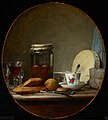
Jean-Siméon Chardin, Jar of Apricots, 1758

François Boucher, The Wooden Shoes, 1768.

Thomas Gainsborough, The Harvest Wagon, 1784–85.
19th century

Paul Kane, Scene in the Northwest — Portrait of John Henry Lefroy, 1845–46.

Pierre-Auguste Renoir, La Seine à Chatou, c. 1871.

James Tissot, The Shop Girl, 1883–1885.

Paul Cézanne, Interior of a forest, c. 1885.

Vincent van Gogh, A woman with a spade, seen from behind, c. 1885.

Jean-Léon Gérôme, The Antique Pottery Painter: Sculpturæ vitam insufflat pictura, 1893.

Paul Gauguin, Nave Nave Fenua from the Noa Noa Series, 1893–94.

Camille Pissarro, Pont Boieldieu in Rouen, Rainy Weather, 1896.
20th century
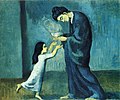
Pablo Picasso, La soupe, c. 1902.

Claude Monet, Charing Cross Bridge, brouillard, 1902.

J. E. H. MacDonald, Fine Weather, Georgian Bay, 1913.

Amedeo Modigliani, Portrait of Mrs. Hastings, 1915.
John W. Waterhouse, I Am Half-Sick of Shadows, Said the Lady of Shalott, 1915.
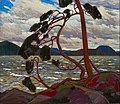
Tom Thomson, The West Wind, 1917.
Augustus John, Marchesa Casati, 1919.

Emily Carr, Church at Yuquot Village (formerly Indian Church), 1929, renamed in 2018.
Tintoretto - Christ Washing His Disciples' Feet, c. 1545–55.- Circle of Hans Holbein the Younger - Portrait of King Henry VIII, c. 1560s.
Gian Lorenzo Bernini, Bust of Pope Gregory XV, c. 1621
Peter Paul Rubens - The Raising of the Cross, oil on paper version, c. 1638.
Tom Thomson, Drowned Land, 1912.
Library and archives
Edward P. Taylor Library & Archives
The Art Gallery of Ontario houses one of Canada's principal art libraries. The library and archives[24] are open to the public and require no entrance fee. The AGO library also serves as the adjunct art history library for OCAD University (formerly the Ontario College of Art and Design) nearby.
General library collections
The general collections of the library reflect the permanent collection of works of art and the public programs of the Art Gallery of Ontario, containing over 300,000 volumes for general art information and academic research in the history of art.[25] The AGO library is a reference library; materials in the collections do not circulate. Holdings encompass western art in all media from the medieval period to the 21st century; the art of Canada's indigenous peoples including Inuit art; and African and Oceanian art.
The library additionally comprises Canadian, American and European art journals and newspapers; over 50,000 art sales and auction catalogues (late 18th century to current); 40,000 documentation files on Canadian art and artists, and international contemporary artists; and multimedia, digital and microform collections. Materials may be searched on the online catalogue.[26] The Library & Archives also produces pathfinders and bibliographies for collections research, such as the Thomson Collection Resource Guide to the large collection of works of art donated by AGO benefactor and collector Kenneth Thomson.[27]
Rare Books and Artists' Books
The AGO's Rare Books Collection includes art historical source books from the 17th century to the present; British Neoclassical folios of the 18th century; catalogues raisonnés; British and Canadian illustrated books and magazines; travel guides, particularly Baedekers, Murrays, and Blue Guides; French art sales catalogues from the late 18th century to the mid-20th century; and artists' books.
Archives and Special Collections
The AGO Archives document the history of the Gallery since 1900, and of The Grange house since 1820. Series include exhibition files, publicity scrapbooks (documenting Gallery exhibitions and all other activity), architectural plans, photographs, records of the Gallery School, and correspondence (with art dealers, artists, collectors, and scholars). Because of the regularity with which artists' groups held exhibitions at the Gallery, the archives are a resource for research into the activities of the Group of Seven, the Canadian Group of Painters, the Ontario Society of Artists, and others.
The Special Collections are one of the most important concentrations of archival material on the visual arts in Canada. In over 150 individual fonds and collections, ranging in date from the early 19th century to the present day, the Special Collections document with primary source material artists, art dealers and collectors, artist-run galleries, and other people and organizations that have shaped the Canadian art world.[28]
Archives and Special Collections are available to the public by appointment.[29]
Online presence

Paintings from AGO's collection, like Ariadne, by Edward Burne-Jones, may be accessed online through Google Arts & Culture.
In keeping with web 2.0 trends, the AGO initiated a social media website called Collection X, together with the Virtual Museum of Canada, which provided users with a space to share ideas about life and art. Collection X showcased the work of contemporary photographers and visual artists and gave users the ability to discuss the works, create online exhibitions and upload their own content. It also contained images of historic value to the museum, such as photographs and former logos, as well as works from the collection.
The AGO is also the first Canadian museum included in the Google Art Project, where 166 pieces from the permanent collection are available for viewing, including works from Paul Gauguin, Bernini, Tom Thomson, Emily Carr, Anthony von Dyck, and Gerhard Richter. Currently, there is no "street view" option to tour the museum online.[30][31]
The AGO can be found on a variety of social media platforms. In the past, this included a Tumblr account that posted one piece of art everyday, part of the museum's ongoing effort to digitize the permanent collection.
Artist-in-Residence program
The AGO's Artist-in-Residence program allows working artists to complete eight-week residencies at the gallery.[32][33] The program, the first of its kind at a major Canadian art gallery, grants each artist access to AGO facilities, a stipend covering materials and living costs, and a dedicated studio, the Anne Lind AiR Studio in the Weston Family Learning Centre.[34][35] Artists-in-residence are invited to create new work and ideas, and to use all media, including painting, drawing, photography, film, video, installation, architecture and sound.[36]
Artists-in-Residence
Gauri Gill (September 2011)[37]
Paul Butler (October–November 2011)[36][38][39][40]
Margaux Williamson (January–March 2012)[34]- Hiraki Sawa (April–July 2012)[41]
- Heather Goodchild (July–August 2012)[42]
Mark Titchner (September–October 2012)[43]
Jo Longhurst (November–December 2012)[44]
Life of a Craphead (January–March 2013)[42]
Jason Evans (April–May 2013)[42]- Mohamed Bourouissa (June–August 2013)[42]
Diane Borsato (September–November 2013)[42]
Sara Angelucci (November 2013–January 2014)[42]
Jim Munroe (January–April 2014)[42]
Ame Henderson (August – October 2014)[45]- Greg Staats (October – December 2014)[42]
- Mammalian Diving Reflex (December 2014 – February 2015)[42]
- FAG Feminist Art Gallery (February – April 2015)[42]
- Meera Margaret Singh (June – August 2015)[42]
- Lisa Myers (September – November 2015)[42]
Jérôme Havre (December – March 2016)[42]- Public Studio (May – July 2016)[42]
- Walter Scott (September – November 2016)[42]
- Will Kwan (January – April 2017)[42]
- EMILIA-AMALIA (May – August 2017)[42]
Tanya Lukin Linklater (August 2017)[42]- Zun Lee (September 2017 – January 2018)[42]
Sara Cwynar (February – April 2018)[42]- Seika Boye and Sandra Brewster (August 2018 – February 2019)[42]
See also
- Culture in Toronto
- List of art museums
- Ontario Association of Art Galleries
- Royal Ontario Museum
References
^ AGO Leadership Team
^ AGO Board of Trustees
^ "About the AGO | Art Gallery of Ontario". Art Gallery of Ontario. Retrieved 2018-08-30..mw-parser-output cite.citationfont-style:inherit.mw-parser-output .citation qquotes:"""""""'""'".mw-parser-output .citation .cs1-lock-free abackground:url("//upload.wikimedia.org/wikipedia/commons/thumb/6/65/Lock-green.svg/9px-Lock-green.svg.png")no-repeat;background-position:right .1em center.mw-parser-output .citation .cs1-lock-limited a,.mw-parser-output .citation .cs1-lock-registration abackground:url("//upload.wikimedia.org/wikipedia/commons/thumb/d/d6/Lock-gray-alt-2.svg/9px-Lock-gray-alt-2.svg.png")no-repeat;background-position:right .1em center.mw-parser-output .citation .cs1-lock-subscription abackground:url("//upload.wikimedia.org/wikipedia/commons/thumb/a/aa/Lock-red-alt-2.svg/9px-Lock-red-alt-2.svg.png")no-repeat;background-position:right .1em center.mw-parser-output .cs1-subscription,.mw-parser-output .cs1-registrationcolor:#555.mw-parser-output .cs1-subscription span,.mw-parser-output .cs1-registration spanborder-bottom:1px dotted;cursor:help.mw-parser-output .cs1-ws-icon abackground:url("//upload.wikimedia.org/wikipedia/commons/thumb/4/4c/Wikisource-logo.svg/12px-Wikisource-logo.svg.png")no-repeat;background-position:right .1em center.mw-parser-output code.cs1-codecolor:inherit;background:inherit;border:inherit;padding:inherit.mw-parser-output .cs1-hidden-errordisplay:none;font-size:100%.mw-parser-output .cs1-visible-errorfont-size:100%.mw-parser-output .cs1-maintdisplay:none;color:#33aa33;margin-left:0.3em.mw-parser-output .cs1-subscription,.mw-parser-output .cs1-registration,.mw-parser-output .cs1-formatfont-size:95%.mw-parser-output .cs1-kern-left,.mw-parser-output .cs1-kern-wl-leftpadding-left:0.2em.mw-parser-output .cs1-kern-right,.mw-parser-output .cs1-kern-wl-rightpadding-right:0.2em
^ "Come and knock on our (new) door". AGO Art Matters blog. Retrieved October 1, 2018.
^ "New David Milne Centre - AGO Press Release". AGO.ca. April 3, 2012. Retrieved October 2, 2018.
^ "General Information Fact Sheet". Art Gallery of Ontario. September 14, 2012. Retrieved October 16, 2012.
^ "Art, technology and archives unite at the AGO's new David Milne Centre" (Press release). Art Gallery of Ontario. April 13, 2012. Retrieved October 16, 2012.
^ "Ontario Society of Artists". concordia.ca.
^ Last Will and Testament of Harriet Goldwin Smith. Archives of Ontario, estate file no. 22382-1909, microfilm MS584, Reel 1822. 1909.
^ "The Grange: Overview | AGO Art Gallery of Ontario". www.ago.net. Retrieved 2018-08-29.
^ "Agreement of the Art Museum of Toronto and the Municipal Corporation of the City of Toronto" (PDF). AGO Art matters. 1911. Retrieved Oct 1, 2018.
^ Canadian Architect. 38 (9): 24. September 1993. Missing or empty|title=(help)
^ "AGO Year in Review - List of First Founders" (PDF). AGO. p. 14. Retrieved September 3, 2018.
^ Frank Gehry. "The Art Gallery of Ontario". designboom.com. Retrieved October 12, 2012.
^ "Kenneth Thomson – a "Great Canadian"". Art Matters blog. Art Gallery of Ontario. June 12, 2006. Retrieved September 21, 2015.
^ ab Kennicott, Philip (November 30, 2008). "A Complex Legacy". The Washington Post. Retrieved February 2, 2009.
^ Hume, Christopher (February 22, 2009). "Art in his blood and steel in his bones". Toronto Star. Retrieved April 13, 2009.
^ Bradshaw, James (November 14, 2008). "Finished AGO puts Gehry's fears to rest". The Globe and Mail. Retrieved September 21, 2015.
^ Hume, Christopher (November 13, 2008). "Revamped AGO a modest masterpiece". Toronto Star. Retrieved February 2, 2009.
^ Ouroussoff, Nicolai (November 14, 2008). "Gehry Puts a Very Different Signature on His Old Hometown's Museum". The New York Times. p. C1. Retrieved February 2, 2009.
^ "About the AGO fact page". AGO. Retrieved August 29, 2018.
^ "Small Wonders: Gothic Boxwood Miniatures". Art Gallery of Ontario. Retrieved 12 February 2017.
^ "The J. S. McLean Centre for Indigenous and Canadian Art". Canadian Art. July 1, 2018. Retrieved August 29, 2018.
^ "The AGO's Edward P. Taylor Library & Archives". Art Gallery of Ontario.
^ "Edward P. Taylor Library & Archives". Art Gallery of Ontario. Retrieved 27 February 2019.
^ "Horizon Information Portal". ago.net.
^ "Edward P. Taylor Research Library: Thomson Collection Resource Guide" (PDF). Art Gallery of Ontario. 2011.
^ "Library & Archives Collection". Art Gallery of Ontario. Retrieved 27 February 2019.
^ "Edward P. Taylor Library & Archives". Art Gallery of Ontario. Retrieved 27 February 2019.
^ Wright, Matthew. "Art Gallery of Ontario becomes the first Canadian museum to participate in the Google Art Project". National Post. National Post. Retrieved January 30, 2016.
^ "Art Gallery of Ontario". Retrieved January 30, 2016.
^ "Art Installation Buzzes With Meditation". At Guelph.
^ "Artist-in-Residence". Art Gallery of Ontario. Retrieved May 17, 2013.
^ ab "Margaux Williamson is the Art Gallery of Ontario's current artist-in-residence". Toronto Star. March 22, 2012.
^ 25k Mocca Award honours arts patrons partners in art. CBC News.
^ ab AGO Launches Artist-in-Residence Program with Winnipeg-born Artist Paul Butler | newz4u.net
^ Ontario, Art Gallery of. "Indian artist Gauri Gill wins $50,000 Grange Prize :: AIMIA | AGO Photography Prize". www.ago.net. Retrieved March 7, 2016.
^ "Reason to Love Toronto: yoga classes at the Art Gallery of Ontario". Toronto Life.
^ Sarah Lazarovic (November 12, 2011). "Why the Art Gallery of Ontario wants you to stretch among the sculptures". National Post.
^ Art Gallery of Ontario offers yoga Archived March 5, 2014, at the Wayback Machine
^ Sky Goodden, ARTINFO Canada. "AGO Announces New Artist-in-Residence, the Celebrated Hiraki Sawa". Artinfo.
^ abcdefghijklmnopqrstu "Artist-in-Residence | AGO Art Gallery of Ontario". www.ago.net. Retrieved March 11, 2017.
^ Lorinc, John (September 14, 2012). "A graffitist who works on the city's dime". The Globe and Mail.
^ "Qatari Sheikh's Unpaid Auction Tab, Corcoran Seeks "Visionary Leader," and More". Artinfo.
^ "Artist-in-Residence". Art Gallery of Ontario. Retrieved July 18, 2014.
External links
| Wikimedia Commons has media related to Art Gallery of Ontario. |
- Official website
"Edward P. Taylor Library & Archives". AGO website. Retrieved September 3, 2018.- AGO at Google Art Project
- AGO 'Art of the Day' on Tumblr
- The Canadian Encyclopedia entry for the AGO































